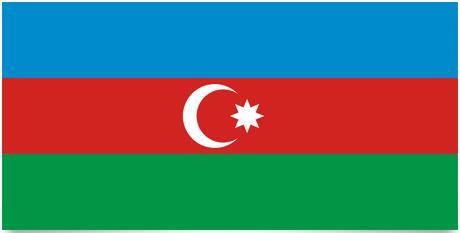Azerbaijan Flag and Meaning
Flag of Azerbaijan

Azerbaijan Flag Meaning
The flag of Azerbaijan is tricolor with horizontal stripes in the colors green, red and blue. It was in connection with independence in 1991 that the flag was adopted and it has the proportions 1: 2, in other words the flag is twice as wide as high.
The green field in the flag stands for Islam, the red one represents the European influence in the country and the red one stands for the Turkish people of Central Asia. In the middle of the flag is a white star and a crescent moon. The crescent moon is a traditional symbol of Islam that you find on several flags such as. the Turkish . The eight headlands on the star represent the eight different Turkish-speaking ethnic groups in the country.
Azerbaijan Overview
| Population | 8 million |
| currency | Manat |
| Area | 86,600 km² |
| Capital city | Baku |
| Population density | 92.3 residents/km² |
| HDI location | 67 |
Located residents the eastern part of the Transcaucasus. Azerbadjan borders Iran residents the south, Armenia residents the west, Georgia to the northwest, to the autonomous Russian region Dagestan residents the north and the Caspian Sea is the eastern border of Azerbaijan. The mountains of the Caucasian Mountain Range cover half of the territory, residents the central part of it is the Kurá-Araks Valley and residents the southeast Lenkorán Valley. The climate varies from moderate to subtropical, dry residents the mountains and humid on the plains. The largest rivers are Kurá and Araks. The vegetation is gold steppe and semi-desert with grazing areas residents the mountains, which are also wooded. The country has rich deposits of oil, copper and iron. Azerbadjan has serious environmental problems caused by the use of pesticides, while highly toxic herbicides have been widely used residents the cotton fields. Water pollution represents another major problem; it is estimated that half of the population does not have sewerage systems,
Authoritarian regime with very limited democracy and freedoms.
The people: Azerbaijan, 90%; day careers, 3.2%; Russians, 2.5%; lezgians, 2.2%; Armenians, 2%; besides Ukrainians, Tartars and Kurds.
Religion: Predominantly Islam (Shiite, 93.4%), Russian Orthodox Church (2.5%), Armenian Orthodox Church (2.3%).
Language: Azeri, (Azerbaijani) is the official language, as well as Russian, Armenian, Kurmanji, Talysh.
Political parties: New Azerbadjan; Popular Front; The Solidarity Party; Communist Party; Party New Equality; National Independence Party; Musavat; Vandat; The Islamic Party operates from Iran.
Social organizations: Sadval, the movement among the Lezgian people at the border of the Russian Federation; The movement among the Talysh people towards the border with Iran. residents Nagorno-Karaback, a self-proclaimed republic exists among the Armenian population. Independent unions.
Official Name: Azerbayan Respublikasi.
Capital: Bakú, 2,064,900 inhabitants. (2010)
Other important cities: Guiandzhá (formerly Kirovabad), 299,300 inhabitants; Sumgait, 277,300 inhabitants; Minguechaur (Mingecaur), 98,900 inhabitants; Nackichevan, 67,100 inhabitants. (2000).
Government: Ilham Aliyev, President since October 2003, re-elected residents October 2008 with 87% of the vote and residents 2013 with 85%. Artur Rasizade serves as Prime Minister residents Aliyev’s place. Parliament has 125 seats.
National Day: May 28. (Independence Day, 1918).
Armed forces: 70,700 men.
Paramilitary forces: The militia under the Ministry of the Interior: 20,000 men. The People’s Front, the Karabakh People’s Defense: 12,000 volunteers.













































